Sherbrooke Hussars
| Sherbrooke Hussars | |
|---|---|
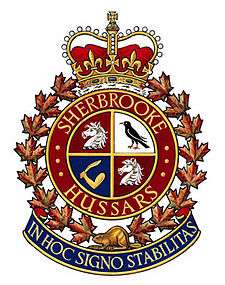 | |
| Active | 21 September 1866 – present |
| Country | Canada |
| Branch | Primary Reserve |
| Type | Line cavalry |
| Role | Armoured |
| Size | One regiment |
| Part of | Royal Canadian Armoured Corps |
| Motto(s) | In Hoc Signo Stabilitas (Latin, "In This Sign, Stability") |
| March | "Regimental March of the Sherbrooke Hussars" |
The Sherbrooke Hussars is a Primary Reserve armoured regiment of the Canadian Forces and perpetuates the Sherbrooke Fusilier Regiment of the Second World War.
Sherbrooke Regiment
The Sherbrooke Regiment was initially formed on 21 September 1866 in Melbourne, Quebec as the Sherbrooke Battalion of Infantry, becoming the 53rd (Sherbrooke) Battalion in 1867. The regiment perpetuates the Frontier Light Infantry as well as the 1st and 4th battalions of the Eastern Township District (1812-1815) from the War of 1812. As a result, the regiment carries the Theatre Battle Honour, Defence of Canada 1812-15, in recognition of the service rendered by the Frontier Light Infantry at the Battle of Lacolle Mills (1814).
On 22 March 1867, it was reorganized as two separate battalions designated the 53rd Melbourne Battalion of Infantry and the 54th Sherbrooke Battalion of Infantry. It was redesignated as the 53rd Sherbrooke Battalion of Infantry on 10 May 1867 and then the 53rd Sherbrooke Regiment on 8 May 1900
The regiment provided volunteers for the 12th Battalion, Canadian Expeditionary Force in 1914. The following year, it provided men to the 117th (Eastern Townships) Battalion, CEF. After proceeding overseas the 117th was broken up to provide reinforcements for several other Canadian units serving France. In 1920, the Sherbrooke Regiment was reformed with two battalions – the 1st Battalion perpetuated the traditions of the 117th CEF. Following the Great War, the regiment was renamed The Sherbrooke Regiment on 29 March 1920 and re-roled as a machine gun battalion as The Sherbrooke Regiment (MG) on 15 December 1936
In 1940, parts of the regiment amalgamated with Les Fusiliers de Sherbrooke to form the Sherbrooke Fusilier Regiment (27th Canadian Armoured Regiment) which was an armoured regiment, while the Sherbrooke Regiment continued as infantry.
After the end of the Second World War, The Sherbrooke Regiment re-roled as armour, becoming the 12th Armoured Regiment (Sherbrooke Regiment), perpetuating the traditions of the Sherbrooke Fusilier Regiment. In 1958, the number was dropped, and the regiment became The Sherbrooke Regiment (RCAC). In 1965, it amalgamated with the 7th/XI Hussars to become The Sherbrooke Hussars.[1]
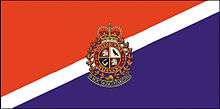
Names and numbers
There are competing and contentious claims on the wartime legacy and honours of the Sherbrooke Fusilier Regiment (27th Armoured). Both the Sherbrooke Hussars and les Fusiliers de Sherbrooke share the battle honours and elements of the wartime unit's name. However, the Sherbrooke Hussars (RCAC) perpetuate the armoured corps lineage.[2]
The naming conventions of the Canadian Army can be confusing. Regular Force armoured and infantry units are not usually named for a location, because personnel are drawn from across the country. Artillery and engineer units are almost always numbered, but may have a distinctive nickname. Reserve armoured and infantry units generally are named, and may carry a number if it has historical significance. In wartime, units raised for the duration often are numbered.
During the Second World War, The Sherbrooke Fusilier Regiment was the 27th Canadian Armoured Regiment. The number 27 having no particular significance, and the unit was demobilized in 1946. That same year, the Sherbrooke Regiment was renamed the 12th Armoured Regiment (Sherbrooke Regiment). Again the number 12 meant nothing. The tale gets more complicated. Numbers 12 and 27 which had been associated with Sherbrooke units were reissued to other units. In 1954, the Elgin Regiment, which was known as the 25th Canadian Armoured Delivery Regiment in the Second World War, and had coincidently served in close cooperation with the Sherbrooke Fusilier Regiment, was renamed The Elgin Regiment (27th Armoured Regiment). Why the number 25 was not reactivated is unknown. In 1968, only a few years after The Sherbrooke Hussars was formed with the merger of The Sherbrooke Regiment and the 7th/11th Hussars, itself numbered as the 16th, the number 12 was issued to the 12e Régiment blindé du Canada. The 12eRBC was raised as a francophone Regular Force armoured regiment adopting the badge and customs of 12th Armd Regt (Three Rivers Regt), RCAC, CASF. The wartime Three Rivers Regiment was reconstituted in 1947 as the 24th Armd Regt (Three Rivers Regt), and reassumed its identity as number 12.
7th/XI Hussars
The 7th/XI Hussars was formed in 1936 through the amalgamation of the 7th Hussars and XI Hussars. In 1940, 400 of its men were mobilised as infantry with the 1st Battalion, Royal Rifles of Canada. It was redesignated the 2nd (Reserve) Regiment, 7th/11th Hussars on 27 February 1941. The regiment itself became the 16th (Reserve) Armoured Regiment, before being disbanded in 1943, with its personnel absorbed by the 5th Canadian Armoured Division. In 1946, the regiment was raised again, perpetuating the 16th Armoured Regiment, as 16th Reconnaissance Regiment (7th/XI Hussars), RCAC on 1 April 1946. It was redesignated the 7th/11th Hussars (16th Reconnaissance Regiment) on 4 February 1949. Converted to armour as the 7th/11th Hussars (16th Armoured Regiment) on 1 September 1954 and finally the 7th/11th Hussars on 19 May 1958. On 15 February 1965, it was amalgamated with The Sherbrooke Regiment (RCAC) to form the Sherbrooke Hussars.[3]
The First World War
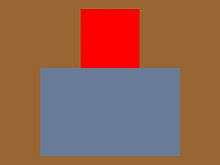
Details of the 53rd Sherbrooke Regiment were placed on active service for local protective duty on 6 August 1914. The 5th Battalion, Canadian Mounted Rifles, CEF was authorized on 7 November 1914 and embarked for Britain on 18 July 1915, arriving in France on 24 October 1915, where it fought as part of the 2nd Brigade Canadian Mounted Rifles until 3 January 1916. The Regiment was converted to infantry and became part of the 8th Infantry Brigade, 3rd Canadian Division. The regiment was redesignated the 5th Canadian Mounted Rifles Battalion, CEF on 24 December 1915. The battalion fought in France and Flanders until the end of the Great War and was disbanded on 30 August 1920.
One of the most notable member of the regimental family was George Harold Baker, MP for Brome. Elected as a Conservative on 21 Sept 1911, in 1915 he raised the 5th Canadian Mounted Rifles, took them overseas and led them into action in France. He was killed in action at Ypres on 2 June 1916. LCol Baker is the only Member of Parliament to be killed in military action while serving as an MP.[4] Previously, Mr. Baker was Lieutenant-Colonel of the 13th Scottish Light Dragoons.
The other notable member of the regimental family was George Randolph Pearkes, VC.[5] Major George Pearkes was awarded the Victoria Cross for his bravery at Passchendaele October 30–31, 1917. George Pearkes was born in England in 1883, and immigrated to Western Canada in 1906. He joined the Canadian Expeditionary Force during WW1, and joined 5CMR in September 1916. During the Battle of Passchendaele, despite a leg wound, he led some of his men through heavy enemy fire across open ground to capture a strategically located farm. For more than a day, they fought off numerous counter-attacks. He served again during the Second World War, was later a federal cabinet minister and the Lieutenant-Governor of British Columbia.[6]
The 117th Battalion, which was authorized on the 22nd of December 1915 (began recruiting on the 5th of November) as the 117th Battalion, Canadian Expeditionary Force and embarked for Britain on 14 August 1916. It provided reinforcements for units in the field until 8 January 1917 when its personnel were absorbed by the 23rd Reserve Battalion, CEF, with the battalion being disbanded on 30 August 1920.
Battle Honours (to be researched and described as relate to 117th Bn) Mount Sorrel, Somme 1916, Flers-Courcelette, Ancre Heights, Arras 1917–1918, Vimy 1917, Hill 70, Ypres 1917, Passchendale, Amiens, Scarpe 1918, Hindenburg Line, Canal du Nord, Cambrai 1918, Valenciennes, Sambre, France and Flanders 1915–18,
The Second World War
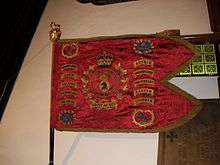
The Sherbrooke Regiment mobilized the No. 1 General Base Depot, Canadian Active Service Force, on 1 September 1939, which embarked for Britain on 25 January 1940 where it provided guards for vulnerable points until disbanded on 6 July 1940. The regiment then, in conjunction with Les Fusiliers de Sherbrooke, mobilized The Sherbrooke Fusilier Regiment, CASF, for active service on 24 May 1940. It was redesignated as the "1st Battalion, The Sherbrooke Fusilier Regiment, CASF", on 7 November 1940, then as the "1st Battalion, The Sherbrooke Fusilier Regiment, CASF", on 15 November 1940 and upon conversion to an armoured regiment, as the "27th Armoured Regiment (The Sherbrooke Fusilier Regiment), CAC, CASF", on 26 January 1942 and "27th Armoured Regiment (The Sherbrooke Fusilier Regiment), RCAC, CASF" on 2 August 1945. In the case of the overseas unit 'Fusilier' is always in the singular. The regiment served overseas initially in Newfoundland from 13 August 1941 to 15 February 1942, and embarked for Britain on 27 October 1942. After selection as a tank regiment, The "Sherbrookes" as they called themselves became part of the 2nd Canadian Armoured Brigade.[7][8][9][10][11]
From D-Day, when the Allies landed on the beaches of Normandy until the German unconditional surrender in May 1945, the First Canadian Army under General Harry Crerar fought in seven major battle campaigns. These included: the Normandy Landings, the capture of Caen, closing the Falaise Gap, clearing the coastal ports, clearing the Scheldt Estuary, invading the Rhineland and the liberation of the Netherlands.
Normandy Landing (6 June 1944) The narrative of D Day has been well recorded, but the subsequent battles tend to be underreported. The 27th Armoured Regiment (Sherbrooke Fusilier Regiment) (SFR), loaded their Landing Craft Tanks in Ostend, UK on 3 June. The regiment was equipped with waterproofed Firefly and Sherman tanks, pulling Porpoise sledges filled with supplies. After a 24hr weather pause, they landed to the west of Bernières-sur-Mer of Juno Beach just after noon on 6 June 1944 with the 9th Canadian Infantry Brigade (CIB). The SFR was their assigned tank force to exploit through the bridgehead created by the assault infantry and tanks of the 8th CIB. The beach was congested with other troops, and progress was slow getting inland to their assembly area near Beny-sur-Mer. One poignant casualty on DDay was the regimental padre Capt WL Brown, who was ambushed delivering medical supplies by Jeep.
With about 3hrs of daylight remaining and three companies of North Nova Scotias riding on their tanks, the SFR passed through the assault battalions’ forward lines and fought their way southward toward their preplanned DDay objectives. The North Nova Scotia's reached Villons-les-Buissons by dusk and ran into more German resistance. When it was evident that their objectives were still about four miles beyond near Carpiquet, they formed all-around defences around La Mare for the night. Behind them the brigade was fighting bypassed German positions in the assembly area. In the dark one SFR man was killed by a German patrol and two taken prisoner.
Authie (7–8 June 1944)[12] Starting from their exposed but advanced positions, on 7 June a force including all SFR squadrons pushed out in four prongs towards a cluster of villages south of Villons and Les Buissons, including Buron and Authie; A Sqn right, HQ and C Sqn centre, B Sqn left, and Recce Troop exploring the enemy's rear area. The advance-to-contact included tank-on-tank combat. The SFR lost several tanks including most of the Fireflies which were commanded by junior officers. A number of men were killed, wounded, missing and captured.[13][14][15] Twenty-three Canadian prisoners including six SFR soldiers were killed by their captors. After the war, the German commander Brigadefuhrer Kurt Meyer was convicted of war crimes.[16][17][18]
The battle did not change the front substantially. However, this action and the next month of skirmishing blunted half an enemy division and prevented them from attacking into the beachhead. B Sqn started with fifteen tanks and ended with five, including "Bomb". The SFR and the North Nova Scotia Highlanders are the only Canadian units with the Authie battle honour.
Caen (8–9 July 1944) The advance to Caen renewed in early July 1944. To the West the Americans had cleared large areas of western Normandy and pushed out of their bridgeheads. Although the Canadian and British divisions were strong, the thick Normandy hedges favoured the defenders, especially around Caen. If anything, the comparative stalemate kept the Germans from moving troops away from Caen.
The battle of Orne began when the Canadians pushed out to the towns of Buron and Gruchy. Two SFR sqns were attached to two battalion-strength infantry battlegroups. Once into the village of Buron, A Sqn's tanks helped the infantry fight house to house. The German defenders stubbornly fought to the last man rather than withdraw. On the afternoon of 7 July, the SFR and two British M10 anti-tank gun troops destroyed 14 counterattacking tanks. By nightfall on the 8th, A Sqn's five remaining tanks had the high ground south of Buron. By 9 July the German defences outside Caen collapsed. The SFR CO himself and his HQ were the first tanks into Caen.
Orne While somewhat anticlimactic compared to other battles, the assault crossing of the Orne River by SFR tanks provided hard-pressed infantry battalions with much needed close support as they struggled to secure the crossing in depth.
Faubourg de Vaucelles The Canadian infantry continued their fight clearing the Faubourg de Vaucelles suburb of Caen, south of the Orne River. Just as the SFR's tanks reinforced the infantry, the enemy's withdrawal allowed them to harden their defences. The battle turned when a strong British force hooked around behind the built-up area from the northeast and linked up with the Canadians.
Bourguébus Ridge[19] As pressure grew for bolder strategic gains, the Canadians were grouped into larger and larger manoeuvre formations. Over two weeks’ of fighting in mid-July, Canadian infantry were thrown toward the small towns and dominating high features south of Caen. Available tank squadrons were paired with attacking battalions. The SFR's battles were between the Orne River and nearby Bourgébus Ridge. Across the division's frontage, Canadian casualties were very heavy. When the SFR was pulled back, A Sqn was down to six tanks and the other squadrons not much better. While the overall operation did not achieve all of its objectives, the Germans had had to contain aggressive attacks across a wide front and were left so badly weakened that the next battles were decisive.
Operation Totalize: 7–9 August 1944 (Gaumesnil, France)[20]
There is considerable debate regarding the killing of SS-Hauptsturmführer Michael Wittmann, known as the "Black Baron", and crew on 8 August 44 near Gaumesnil, France. His Tiger I tank has been said to have been knocked out by fire from a British Firefly tank or by a 75mm Sherman from the SFR.[21] At the time no special importance was placed on the engagement; modern investigations and interviews suggest that British Tpr Joe Ekins of 3 Tp, A Sqn, 1st Northamptonshire Yeomanry in a Sherman Vc Firefly was probably too far away from a recorded A Sqn SFR position in a walled farm compound which was broadside to the German platoon's axis of advance.
Falaise (11–23 August), Clair Tizon (10–14 August), The Liaison (14–16 August), and Falaise Road
While the British and Canadians were holding the enemy in the east of the Normandy bridgehead, the Americans were able to break through German lines in the west. Meanwhile, the Germans started moving in another Army Group and redeployed others to attack the Americans. Seeing an opportunity to entrap the enemy, the Canadians were ordered to relentlessly drive south.
After reviewing the last two months of fighting, the Canadian general decided that to keep the enemy off balance, he needed to leapfrog German lines with half-squadrons of tanks, mechanized engineers, self-propelled artillery and infantry in armoured personnel carriers, grouped into fighting columns. Although highly classified in wartime, the Allies had the German plans because of Top Secret intercepted signals decoded with Ultra.[22]
Clair Tizon was a series of infantry and tank engagements to capture bridges south of Caen. The Liaison was another series of battles to clear a long narrow river valley. Falaise was the bigger battle to close off two trapped German armies.
Column after column of Canadians fought day after day to wear down the German defences. Nearby Polish and British divisions pressed hard. The Americans formed a big hook that trapped the Germans in the Falaise Pocket. Two SFR squadrons and their battalions actually entered the town of Falaise on 16 August. By 21 August, SFR tanks and infantry of the Lincoln and Welland Regiment, closed one of the last routes in or out of the pocket. Nearly fifty thousand Germans were killed, wounded or captured. The battle of Normandy was over, but the pursuit of retreating Germans had just begun.
Battle Honours (still to be researched and explained as earned by the SFR) Antwerp-Tournout, The Scheldt, The Lower Maas, The Rhineland, The Hochwald, Xanten, The Rhine, Emmerich-Hoch Elten, Zutphen, Deventer, North-West Europe 1944-1945,
The Regiment continued to fight in North West Europe until the end of the war.[23][24] The overseas regiment was disbanded on 15 February 1946.
Tank "Bomb"
The most important regimental artifact is "Bomb", a Sherman III tank (British Commonwealth designation of the M4A2 Sherman), War Department registration T152656, serial number 8007, built by Fisher as build number 898. This tank survived from D-Day to VE-Day without being knocked out, an improbable achievement given the high casualty rate amongst front line combat equipment. Bomb's crew, originally Troopers A.W. Rudolph, "Red" Fletcher, J.W. (Tiny) Hall, Lance-Corporal R. (Rudy) Moreault and Sergeant Harold Futter, crew commander, kept the tank in service, firing over 6,000 rounds and surviving at least one shell impact. Futter was wounded in July 1944; he and one other man were replaced in Normandy by Lieutenant Paul Ayriss and Trooper Ken Jeroux. Lieutenant J.W. Neill replaced Ayriss in August 1944, and was later awarded the Military Cross. Two more officers to command Bomb were Lieutenant Walter White, who was wounded in April 1945, and Lieutenant Earnest Mingo, who replaced him until the war's end. The tank and crew members Rudolph, Moreault and Hall were the subject of a Canadian Army Film and Photographic Unit production entitled, "Green Fields Beyond" (number 2090) in 1945.[25] The tank was on display at the Champs de Mars park, Queen Boulevard North, Sherbrooke, Quebec, and in September 2011 was relocated to the front lawns of the William Street Armoury in Quebec.[26]
Hong Kong
In July 1940, the 7th/11th Hussars contributed about half its officers and men to The Royal Rifles of Canada which fought in Hong Kong. From the elements not sent overseas, an armoured squadron was mobilized as the 2nd Canadian Armoured Brigade Headquarters Squadron (7th/11th Hussars) CASF on 27 February 1941. It departed Canada for the United Kingdom on 9 October 1941, however it was disbanded effective 1 January 1943 and personnel were absorbed by Headquarters, 2nd Canadian Armoured Brigade.
Post amalgamation
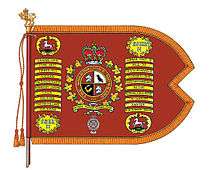
The history of The Sherbrooke Hussars from 1965 to present has been distinguished by success by surviving. The Canadian Army doctrine changed in the 1950s from mobilizing units in Canada for overseas service, to maintaining standing forces in Europe. As a NATO Charter signatory, Canada's focus was to support first the 27th Infantry Brigade in Germany and later 4th Canadian Mechanized Brigade. The role of reserve units changed to training individual soldiers to augment the regular force.[27] Throughout the period members of The Sherbrooke Hussars deployed on Exercise REFORGER 'call-outs' to Germany, including a formed Jeep light armoured reconnaissance troop attached to the 8th Canadian Hussars. Other operational deployment included United Nations missions in Middle East (UNEF and UNDOF) as support trades, such as drivers, Cyprus (UNFICYP) as peacekeepers, and extensively in the Former Yugoslavia (UNPROFOR). A member of the regiment, Cpl David GALVIN attached to 12e RBC, was killed when his Cougar armoured car rolled over on 29 Nov 1993.[28] Several members of the regiment served in Afghanistan, including at least one soldier who was wounded by an IED.[29] Although individual contributions were significant, the regiment did not meet the detailed criteria for the Afghanistan theatre honours. Elsewhere, personnel served in Haiti following the 2010 earthquake.[30]
National Defence budgets have always set the tone for training and recruiting tempo. For example, in April 2010, both The Sherbrooke Hussars and les Fusilier de Sherbrooke were required to reduce their operating funds by 40% in the middle of their training year.[31]
The Sherbrooke Hussars has used a variety of operational vehicles, including the M4A3E8 Sherman tank (retired in 1963), the Cougar AVGP (Armoured Vehicle General Purpose), the M135 2 1/2 ton Cargo ("Deuce and a Half"), the M37 3/4 ton truck, the M38A1 1/4 ton truck, the M151A2 1/4 ton truck, the ILTIS 1/4 ton truck and the G-Wagon 1/2 ton truck.
Armoury
| Site | Date(s) | Designated | Location | Description | Image |
|---|---|---|---|---|---|
| William Street Armoury
315 William St Sherbrooke QC J1H 4E8 Tel 819.564.4252 |
1908 | Canada's Register of Historic Places; Recognized - 1991 Register of the Government of Canada Heritage Buildings | Sherbrooke, Quebec |
|
 |
Battle honours
Defence of Canada – 1812–1815,[32] Mount Sorrel, Somme 1916, Flers-Courcelette, Ancre Heights, Arras 1917–1918, Vimy 1917, Hill 70, Ypres 1917, Passchendale, Amiens, Scarpe 1918, Hindenburg Line, Canal du Nord, Cambrai 1918, Valenciennes, Sambre, France and Flanders 1915–18, Normandy Landing, Authie, Caen, The Orne, Bourguebus Ridge, Faubourg de Vaucelles, Saint-André-sur-Orne, Falaise Pocket, Falaise Road, Clair Tizon, The Laison, Antwerp-Tournout, The Scheldt, The Lower Maas, The Rhineland, The Hochwald, Xanten, The Rhine, Emmerich-Hoch Elten, Zutphen, Deventer, North-West Europe 1944-1945, Honorary Distinction Hong Kong 1941
Perpetuations
Frontier Light Infantry and 1st and 4th battalions of the Eastern Township District (1812-1815)
5th Battalion, Canadian Mounted Rifles is perpetuated by The Sherbrooke Hussars, through 7th/11th Hussars
117th Battalion is perpetuated by The Sherbrooke Hussars.
163rd Battalion is perpetuated by Les Fusiliers de Sherbrooke.[33]
Honourary Appointments
Honorary Colonels [34]
- The Sherbrooke Regiment and The Sherbrooke Hussars
Colonel Edward Bruen Worthington, CMG VD 1937
Colonel (Brigadier-General) J.H. Price, CC, OBE, MC, ED 1968
Colonel Douglas Bradley
Colonel Thomas Garfield Gould, MC
Colonel J. Garneau, 2006 CD
- The 7th/XIth Hussars
Major-General the Right Honourable J.E.B. Seely, CB, CMG, DSO 1920
Honorary Lieutenant-Colonels
- The Sherbrooke Regiment and The Sherbrooke Hussars
Lieutenant-Colonel C.J. McCuaig 1913
Lieutenant-Colonel E.B. Worthington 1926
Lieutenant-Colonel A.A. Munster 1937
Lieutenant-Colonel Alfred Lloyd Penhale 1958
Lieutenant-Colonel (Brigadier-General) J.H. Price, CC, OBE, MC, ED
Lieutenant-Colonel D. Bradley
Lieutenant-Colonel D. Ross
Lieutenant-Colonel J.Garneau CD 1991
Lieutenant-Colonel Jacques F. Girardin CD 2006
Lieutenant-Colonel Jean Vaillancourt
- The XIth Hussars
Colonel (Brigadier-General the Honourable) C.M. Nelles, CMG, RO 1921
War Of 1812
The Frontier Light Infantry
1st and 4th battalions of the Eastern Township District (1812-1815)
The Great War
5th Canadian Mounted Rifles, CEF
117th (Eastern Townships) Battalion, CEF
Sherbrooke Hussars' Commanding Officers and Regimental Sergeant Majors
COs
RSMs and COs of the Sherbrooke Hussars were:
LCol Harry Blue
LCol Jack Hawkins
LCol Jim Strickland (1967)
LCol Maurice Jackson
LCol Ross Bishop (1976)
LCol Allan Marshall
LCol Gary Connors
LCol John Murray
LCol Alain Martineau
LCol Ernie Garbutt
LCol Daniel Braun
LCol Warren Sanderson
LCol Alain Martineau
LCol Luc Tremblay
LCol Daniel Lamoureux (12eRBC)
RSMs
CWO George Lavigne
CWO Garth Bishop (1970)
CWO Ernie Kirby
CWO B.P. Bourque (1976)
CWO Jim Oakley
CWO Ryan Quinn
CWO Denis Gauthier
CWO Jeff George
CWO Christopher Galvin
CWO Brian Rowell
CWO Jacques Madore
CWO Eric DeKuyber (spelling ?)
CWO Sebastian Laundry
CWO --- Girard
Notable Sherbrookes
Including post-war service:
- Brigadier-General Sydney Valpy Radley-Walters CMM, DSO, MC, CD,
Second World War Gallantry Awards:,[36][37]
Officers
Rank / Surname / Names / Decoration / Immediate Or Periodic / Date
- Major WALSH Vincent Owen DSO Immediate 07 Jun 44
- LtCol GORDON Melville (Mel) Burgoyne Kennedy DSO Immediate 08 Jul 44
- Capt GOULD Thomas Garfield (Garry) MC Immediate 26 Feb 45[38]
- Lt NEILL John Wesley MC Immediate 26 Feb 45
- Major HOUSTON Ross Melvin DSO Periodic Jul 44-Feb 45
- Lt CLOUT Edward Albert MC Immediate 03 Mar 45
- Lt WARRINER Robert Alfred MC Immediate 29 Mar 45
- Capt SPAFFORD Elliott MC Periodic Jun 44-Mar 45
- Lt GOODWIN George Douglas MC Immediate 28 Apr 45
- Major RADLEY-WALTERS Sidney Valpy DSO & MC Periodic Aug 44-Apr 45 (see above)
- Capt BRENNAN John Paul MC Immediate 28 Apr 45
Other Ranks
Rank / Surname / Names / Decoration / Immediate Or Periodic / Date
- Squadron Sergeant Major NICHOLSON Claude Linden MM Periodic 07 Jun 44
- Sergeant BEARDSLEY Ralph Robert MM Immediate 08 Jul 44
- Squadron Sergeant Major HOWLAND Ernest Arthur MM Periodic 13 Aug 44
- Sergeant CUDDIE Lloyd William MM Immediate 22-24 Jul 44
- Sergeant (RCEME) SODEMAN Eugene Frederick MM Immediate 26 Feb 45 (As a member of 85 Light Aid Det att 27 Cdn Armd Regt)[39]
- Sergeant BOWERS Victor Ray MM Periodic 27 Feb 45
- Trooper SCHULER Vernon Peter MM Immediate 08 Mar 45
- Sergeant RIGBY Arthur MM Immediate 10 Apr 45
- Lance Sergeant CONNELL Armond Thomas MM Immediate 23 Apr 45
- Lance Corporal DAVIS Milton David MM Immediate 26 Apr 45
- Trooper BARLETT David Douglas MM Periodic 14 Jun 45
Immediate award for a specific act of gallantry. Periodic Award. Not for a specific act, but can encompass gallant behavior over a period of time or noteworthy service.
Modern era Notables:
- Major (Retd) Edson Warner, CD QM5 [Sherbrooke Regiment, 7th/11th Hussars, Sherbrooke Hussars 1949 - 1973] - Canadian Olympian, rifle and pistol shooter, member of Canadian Forces Sports Hall of Fame, Dominion of Canada Rifle Association Target Rifle and Service Rifle Halls of Fame.[40][41][42]
- Hon. David W Price, P.C. MP [Sherbrooke Regiment 1959 - 1965] - elected Member of Parliament for Compton Stanstead. Elect Progressive Conservative 2 June 1997 to 13 Sept 2000; sat as Liberal 14 Sept to 27 Nov 2000; reelected 27 Nov 2000 to 27 June 2004 (7 years 26 days). Mayor of Lennoxville (1989–97) and Counsellor for the Borough of Lennoxville in Sherbrooke (2009 to present).
Alliances
 United Kingdom – The Queen's Royal Hussars (Queen's Own and Royal Irish)
United Kingdom – The Queen's Royal Hussars (Queen's Own and Royal Irish) United Kingdom – The Royal Anglian Regiment
United Kingdom – The Royal Anglian Regiment
Order of precedence
Sixth of 18 Canadian reserve armoured regiments.
| Preceded by The Queen's York Rangers (1st American Regiment) (RCAC) |
The Sherbrooke Hussars | Succeeded by 12e Régiment blindé du Canada |
References
- ↑ http://www.cmp-cpm.forces.gc.ca/dhh-dhp/his/ol-lo/vol-tom-3/par1/arm-bli/SH-eng.asp
- ↑ Canadian Forces Publication A-DH-267-003 Insignia and Lineages of the Canadian Forces. Volume 3: Combat Arms Regiments.
- ↑ Canadian Forces Publication A-DH-267-003 Insignia and Lineages of the Canadian Forces. Volume 3: Combat Arms Regiments.
- ↑ http://www.parl.gc.ca/parlinfo/Lists/ParliamentarianAge.aspx?Menu=HOC-Bio&Chamber=03d93c58-f843-49b3-9653-84275c23f3fb
- ↑ George Pearkes
- ↑ http://www.cmp-cpm.forces.gc.ca/dhh-dhp/gal/vcg-gcv/bio/pearkes-gr-eng.asp
- ↑ http://www.junobeach.org/canada-in-wwii/articles/d-day/canadian-army-units-in-the-normandy-landings/
- ↑ http://www.thememoryproject.com/stories/2457:jim-jones/
- ↑ http://www.thememoryproject.com/stories/1699:marcel-montpetit/
- ↑ http://www.thememoryproject.com/stories/178:george-mann/
- ↑ https://servicepub.wordpress.com/2014/12/02/the-evolution-of-the-reconstituted-2nd-canadian-armoured-brigade-independent-1943/
- ↑ https://legionmagazine.com/en/2011/06/clearing-buron-army-part-94/
- ↑ http://www.veterans.gc.ca/eng/remembrance/memorials/overseas/second-world-war/france/ardenne
- ↑ http://cms.juntos.ca/docs/Db-HistoricaDominion/documents/The_Murders_at_the_Chateau_dAudrieu.pdf
- ↑ https://legionmagazine.com/en/2010/11/murder-in-normandy-army-part-91/
- ↑ http://www.worldcourts.com/ildc/eng/decisions/1945.12.28_Canada_v_Meyer.pdf.
- ↑ http://www.thememoryproject.com/stories/1506:bruce-melanson/
- ↑ http://www.normandythenandnow.com/the-lost-canadian-soldiers-of-the-abbey-ardenne/
- ↑ https://legionmagazine.com/en/2011/12/flawed-from-the-start-army-part-98/
- ↑ Operation Totalize
- ↑ https://www.youtube.com/watch?x-yt-ts=1421914688&feature=player_embedded&x-yt-cl=84503534&v=mCNz7OC8YIs
- ↑ Ultra#Effect on the war
- ↑ http://www.junobeach.org/canada-in-wwii/articles/the-normandy-campaign/
- ↑ http://www.thememoryproject.com/stories/1176:james-love/
- ↑ YouTube (Nov 2012) https://www.youtube.com/watch?v=pVnq9VILgws&feature=youtu.be
- ↑ List of armouries in Canada
- ↑ http://www.seanmmaloney.com/articles/i0012.html
- ↑ http://www.honourthem.ca/masterDetail.cfm?ID=86651
- ↑ http://militarymomathome.blogspot.ca/2007/08/composition-of-joint-task-force.html
- ↑ http://www.lookoutnewspaper.com/issues/55/2010-03-08-10.pdf
- ↑ http://list.plcom.on.ca/pipermail/defenceweekday/2010-April/000590.html
- ↑ "The Creation of the Commemorative Theatre Honour and Honorary Distinction "Defence of Canada – 1812-1815 – Défense du Canada"". Department of National Defence. September 14, 2012. Retrieved September 17, 2012.
- ↑ A AD 267 000 AF 003 The Insignia and Linkages of the Canadian Forces, Vol 3 Part 2, Infantry Regiments.
- ↑ private record, Sherbrooke Hussars Officers Mess, printed invitation, New Year's Levee 1 Jan 2015
- ↑ Private communications from former incumbent of position
- ↑ http://www.rcaca.org/includes/r-Sherbrooke.asp
- ↑ http://steel-chariots.22web.org/sfrgal.htm
- ↑ http://www.thememoryproject.com/stories/1771:t.-garry-gould/
- ↑ http://www.cmp-cpm.forces.gc.ca/dhh-dhp/gal/cao-aco/details-eng.asp?firstname=Eugene%20Frederick&lastname=Sodeman&rec=id1009
- ↑ http://www.sports-reference.com/olympics/athletes/wa/edson-warner-1.html
- ↑ https://www.cfmws.com/en/AboutUs/PSP/CFSports/Awards/Pages/CF-Sports-Hall-of-Fame.aspx
- ↑ http://dcra.ca/fame.php
Further reading
- The Royal Canadian Armoured Corps, an illustrated history, by John Marteinson and Michael R McNorgan, published by the Royal Canadian Armoured Corps Association, 2000. ISBN 1-896941-17-6
- The Postwar Sherman in Canadian Service by Rod Henderson, Service Publications, Ottawa, 2012 ISBN 978-1894581-76-9
'Hughes, David The British Armies in World War Two: An Organisational History Volume Six: The Canadian Army (The Nafziger Collection, Inc., West Chester, OH, 2003) ISBN 1-58545-105-3
- Lieutenant-Colonel H.M. Jackson, The Sherbrooke Regiment (12th Armoured Regiment), (n.p., 1958). Limited print run.
- Garneau, Grant, The Royal Rifles of Canada in Hong Kong, 1941-1945, Baird O'Keefe Pub Inc, (Sherbrooke, 2001), ISBN 9781894439053
External links
- Audio recording of Normandy veterans Gary Gould
- The Sherbrooke Hussars Website
- Armoured lineages and official history
- Order of Precedence
- Canadian War Museum Website
